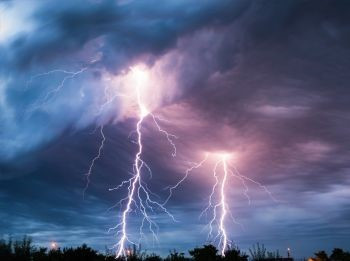 Establishing “Why” Since 1966
Establishing “Why” Since 1966
A bolt of lightning is one of nature’s most dangerous events. Lightning can travel at around 140,000 miles per hour and reach temperatures of 50,000°F ˗˗˗ hot enough to turn sand into glass. In 2014, one major insurance carrier individually paid out nearly $149 million dollars for insurance claims as a result of damage from lightning strikes.
Forensic Analysis & Engineering’s team of qualified engineers can investigate any structure where lightning is a suspect cause of damage.
Lightning presents three main hazards to a building that is struck directly:
- Fire danger: The biggest danger lightning poses to any structure is fire. Wood and other flammable building materials can easily be ignited anywhere an exposed lightning channel comes in contact with (or passes through) them. It is most common for lightning to start a fire in the attic or roof of a house, as the channel usually has to pass through some of the structural material in the roof before it can reach a more conductive path to ground such as electrical wiring or water piping. When a bolt of lightning current travels through wires, it will commonly over charge them – presenting a lasting fire ignition hazard anywhere along the affected circuits.
- Power surge damage: If lightning chooses any of the home’s electrical wiring as its primary or secondary path to ground, the explosive surge can damage even non-electronic appliances that are connected. Even if most of the lightning current takes other paths to ground, the home’s electrical system will experience enough of a surge to cause potentially significant damage to anything connected to it, sensitive electronics in particular.
- Shock wave damage: Another major source of damage from lightning is produced from the explosive shock wave. The shock waves that lightning create is what produces the thunder that we hear, and at close range, these waves can be extremely destructive. Lightning can easily fracture concrete, brick, cinderblock and stone. Brick and stone chimneys are commonly damaged severely by lightning. Lightning’s shock waves can blow out plaster walls, shatter glass, create trenches in soil and crack foundations. Shrapnel is a common secondary damage effect, with objects sometimes found embedded in walls.
When it comes to lightning claims, some insurance companies want to know which damage was the result of a lightning-caused fire and what damage was from the electrical overload. In some cases, the insurer will often want to know precisely where the electrical surge originated, because they may not cover a damage claim if the surge originated off the premises. Insurance companies also differentiate between a lightning strike and a power surge and frequently ask our investigators who examine the property to attest to the fact that the power surge came specifically from a lightning strike, since surges can also be the result of faulty transformers or failed power lines.
Not all lightning claims are actually related to a lightning strike though. Most damage observed to exterior HVAC units, for instance, is related to bad and/or aged connections, weather infiltration, lack of proper maintenance of mechanical systems and in some cases, abuse and/or neglect. Condensed moisture in the refrigerant system can also damage the insulation on the compressor’s windings which has led many to believe that a lightning strike has occurred. A careful on-site examination and testing of all damaged components by a qualified professional forensic engineer equipped with proper testing equipment can determine the truth.
What does it take to verify lightning claims?
FAEC’s team of electrical forensic engineers are qualified, and routinely called upon to evaluate and analyze both the design and application containing simple and complex circuitry, which is used for machine control, communications, and power generation & distribution to determine the cause of system failures. FAEC can also determine and evaluate causes to damaged residential and electrical systems, components and appliances. Forensic Analysis & Engineering’s experienced engineers are able to reconstruct any loss or accident and evaluate defective appliances to answer the primary question of “WHY did the loss or accident occur?” Through that knowledge FAEC can provide assistance in preventing future failures.
To find out more or submit an investigation request, visit our website at www.forensic-analysis.com.


Recent Comments